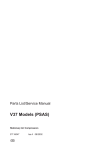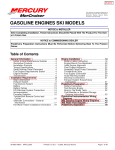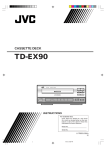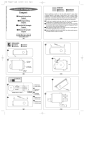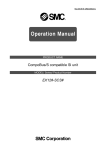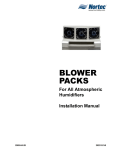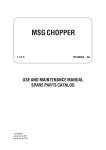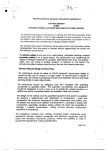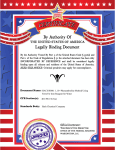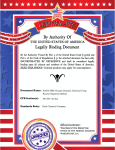Download ABYC P-04: Marine Inboard Engines
Transcript
By Authority Of
THE UNITED STATES OF AMERICA
Legally Binding Document
By the Authority Vested By Part 5 of the United States Code § 552(a) and
Part 1 of the Code of Regulations § 51 the attached document has been duly
INCORPORATED BY REFERENCE and shall be considered legally
binding upon all citizens and residents of the United States of America.
HEED THIS NOTICE: Criminal penalties may apply for noncompliance.
e
Document Name:
ABYC P-04: Marine Inboard Engines
CFR Section(s):
46 CFR 182.420(b)
Standards Body: American Boat and Yacht Council
Official Incorporator:
THE EXECUTIVE DIRECTOR
OFFICE OF THE FEDERAL REGISTER
WASHINGTON, D.C.
P-4 (13)
1-10-89
P-4
MARINE INBOARD ENGINES
Based on ABYC's assessment of the state of existing technology and the problems associated with achieving the
requirements of this standard, ABYC recommends compliance with this standard by August 1, 1990.
P-4.1.
PURPOSE
These recommended practices and engineering standards establish requirements for the design,
construction, installation and selection of materials for inboard engines and their transmissions used
for propulsion of boats and to power their auxiliary equipment.
P-4.2.
SCOPE
These recommended practices and engineering standards apply to all inboard engines.
NOTE:
P-4.3.
Under the authority granted by the Federal Boat Safety Act of 1971 the U.S. Coast
Guard has promulgated Federal Regulation 33 CFR Part 183, Subparts l, 1, and K
relative to small craft electrical, fuel, and ventilation systems. They affect the design,
construction and installation of engines. These regulations became effective during the
period from August 1, 1977 to August 1, 1980. Federal regulations are reviewed and
periodically revised, and thus applicable portions should be consulted for the most
recent wording.
DEFINITIONS
a. Accessible - Capable of being reached for inspection, removal or maintenance without removal of
permanent boat structure.
b. Automatic Operation - Self-acting; designed to start, run and stop without an operator when actuated by one or more control devices sensitive to a change in temperature, pressure, voltage, or
a mechanical action.
c. Closed Cooling System - A system which uses recirculating liquid in the engine water jacket for
cooling purposes and where the recirculated liquid is cooled through an internal or external exchanger.
d. Readily Accessible - Capable of being reached quickly and safely for effective use under emergency conditions without the use of tools.
e. Seawater Cooling System - A system which circulates flotation water through the engine jacket for
cooling purposes, and then discharges the water overboard.
P-4.4
REFERENCE
SAE - Society of Automotive Engineers. The referenced standards may be obtained from the
Society of Automotive Engineers, 400 Commonwealth Drive, Warrendale, PA 15096.
©
1989 American Boat and Yacht Council, Inc.
1
P-4 (13)
1-10-89
P-4.S.
REQUIREMENTS - IN GENERAL
a. Marine engines shall be designed for saltwater operation.
b. Air supply to engines shall be sufficient to comply with installation instructions provided by the
engine supplier for combustion air and heat control and shall comply with ABYC H-2, "Ventilation of Boats Using Gasoline" or with ABYC H-32, "Ventilation of Boats Using Diesel Fuel".
c. The equipment and arrangement of component parts of the engine, installed in accordance with
the installation instructions, shall be accessible, without the use of tools, for normal maintenance
of the engine (e.g. oil fills, dip sticks, cooling water fills).
d. Provision shall be made for removal of substantially all of the oil from the engine sump without
spillage of oil into the bilge.
e. All exposed belt drives, chain drives and rotating parts, as installed, shall be covered with guards
or shall be designed in such a way as to prevent injury during the normal operation of the engine.
An engine box shall be considered as serving the purpose of this paragraph. Maintenance or
engine repairing are not considered normal operation.
f.
Belts shall be changeable without dismantling any major part of the engine.
g. Protective guards, jacketing, or engine boxes shall be provided wherever persons or gear might
come in contact with the engine or its components as installed in normally occupied spaces,
where their temperature exceeds 200 F (93 C).
0
0
h. Engine accessory equipment shall be manufactured and installed so that it can be serviced and
lubricated as required and recommended.
1.
P-4.6.
Non-propulsion engines intended for automatic operation shall be equipped with an automatic
shut-down device actuated by low oil pressure, excessive engine heat, loss of exhaust coolant
flow, excess exhaust pipe or excess exhaust gas ducting heat.
DESIGN AND CONSTRUC110N
a. Cooling system temperatures shall conform to the manufacturer's recommendations.
b. If a pump is used to supply seawater for cooling an engine and its systems, a self-priming pump
which operates whenever the engine is running shall be used.
c. The water discharged from an engine, if used to cool a wet exhaust system, shall be sufficient to
insure adequate flow to the system in accordance with ABYC P-l, "Exhaust Systems". A by-pass
may be used where the full flow would cause an exhaust back-pressure exceeding the engine's
recommendations.
d. Any engine employing a keel cooler or other outboard heat-exchanger system shall have an independent self-priming pump to supply cooling water for the exhaust, exhaust manifold, and
coolers, if seawater cooled. The pump shall operate whenever the engine operates.
© 1989 American Boat and Yacht Council, Inc.
2
P-4 (13)
1-10-89
(P-4.6)
e. Those portions of the engine through which saltwater circulates and which consist of metal alloys
shall be of such area relationship as to avoid detrimental galvanic corrosion. In general, components of small relative area, such as core plugs and pipe plugs, shall be made of materials
which in the galvanic series are cathodic to and close to the other metal alloys with which they
are used.
EXCEPTION:
f.
If a closed fresh water cooling system is provided as pan of the basic engine.
Drains or drain plugs shall be provided in liquid cooled engine systems to aid drainage so that
when the engine is installed according to recommendations they will assist in avoiding damage
from freezing.
g. Applications using engine jacket water as a heat source shall be installed in accordance with the
recommendations of the engine and appliance manufacturers.
h. On air-cooled engines, factory installed engine air cooling shrouding shall be constructed and
mounted in such a manner as to trap all engine cooling air and lead it to a point from which it
can be discharged outside the hull or engine box by means of a duct or ducts.
1.
Due to the potential hazard of carbon monoxide poisoning, engine cooling air discharge duct(s)
or openings from air-cooled engines shall not be used to provide a direct source of cabin heat.
j.
Ducts for cooling air intake and discharge for air-cooled engines shall be constructed of fire resistant materials.
k. Engine oil pans or sumps shall be resistant to corrosion.
1.
Means shall be provided to determine the correct oil level in the engine as it is installed.
m. Engine crankcases shall be properly vented to prevent excessive pressurization. Crankcase fumes
shall not be discharged into the engine room during the operation of the engine. Crankcase
fumes may be discharged into the airstream entering the engine air intake.
n. Electrical Systems
(1)
Negative ground shall be considered as the standard ground for engine systems.
(2)
All electrical components which are integral parts of the engine shall be mounted as
high as practical.
(3)
If used, ignition coils and magnetos shall be mounted or protected so that water will not
accumulate around the high voltage cap.
(4)
Electrical systems shall conform to all applicable sections of ABYC E-9, "Direct Current
(DC) Electrical Systems Under 50 Volts".
© 1989 American Boat and Yacht Council, Inc.
3
P-4 (13)
1-10-89
(P-4.6.n.)
(5)
If an electrical component is required to be ignition protected and bands or other covers
form part of the ignition protection enclosure:
(a)
the band or covers shall be permanently and visibly marked with a caution or
warning saying, in effect, that it must be in place when the engine is operating,
or
(b)
it shall be noted in the owner's or service manual.
(6)
High tension cable assemblies shall conform to SAE J1191, JAN86, or subsequent revisions.
(7)
Ignition distributors shall conform to SAE 11294, JAN86, or subsequent revisions.
(8)
Shorting switches for magneto ignition systems shall be located outside engine and fuel
compartments or shall be ignition protected.
o. Fuel System
(1)
Metallic fuel system components installed on an engine shall be resistant to saltwater
corrosion or shall be externally treated with a corrosion resistant coating. Metals and
metal alloys used in an engine fuel system shall be selected to minimize galvanic corrosion.
(2)
Flexible engine fuel hoses shall be equipped with permanently installed end fittings, such
as swaged sleeve or a sleeved and threaded insert, or may be secured with corrosion
resistant metallic clamps. Clamps depending solely on spring tension of the metal shall
not be used. Clamps shall be installed directly on the hose and shall not overlap each
other. Clamps shall have at least a nominal width as indicated in Table I.
TABLE I - HOSE CLAMP WIDTHS
Outside Hose Diameter
Minimum Nominal Clamp Width
Less than 7/16"(11.11mm)
1/4"(6.35mm)
7/16"(11.11mm) thru
13/16"(20.64mm)
5/16"(7.94mm)
Over 13/16" (20.64mm)
3/8"(1O.OOmm)
Clamps shall be installed at least 1/4" (6mm) from the end of the hose.
(3)
Engine mounted fuel system components shall be capable of withstanding a 2-1/2
minute exposure to free burning fuel, N-heptane, or No.2 diesel fuel as applicable.
EXC'EPTION:
(4)
Carburetors.
Fuel pumps shall not vent into the engine compartment.
© 1989 American Boat and Yacht Council, Inc.
4
P-4(13)
1-10-89
(P-4.6.0.)
(5)
Fuel pump operating pressure relief shall be accomplished internally within the fuel
system.
(6)
Fuel filters on engines shall be self-supporting.
(7)
Glass filter bowls shall not be used.
(8)
Fuel filters shall not incorporate drain cocks of any type. Drain plugs are permissible.
(9)
Marine carburetors shall comply with SAE J1223, DEC80, or subsequent revisions.
(10)
All engine fuel system connections shall be accessible.
p. Marine Transmissions
(1)
The transmission shall be designed to prevent thrust upon the crankshaft of the engine.
(2)
The transmission shall be able to withstand momentary overspeeds of 115% of the maximum rated engine speed in forward and reverse.
(3)
Transmissions incorporating an independent oiling system shall include a suitable oil
sump, a method of measuring oil, and a vent located to provide adequate breathing, but
positioned to prevent oil leakage from the transmission under normal operating conditions.
(4)
Transmissions shall be provided with a method of cooling so that recommended maximum sump temperatures will not be exceeded under normal operating conditions.
(5)
Hydraulically actuated transmissions shall have a provision to monitor oil pressure
and/or oil temperature as specified in the operating instructions.
(6)
Transmission Identification Label - Each transmission shall have identification marks or
labels of corrosion resistant material permanently attached, which shall contain at least
the following information:
(a)
Manufacturer's name or identifying mark.
(b)
Model number.
(c)
Serial number.
(d)
Ratio.
© 1989 American Boat and Yacht ('.oundl, Inc.
5
P-4 (13)
1-10-89
P-4.7.
INSTRUMENTATION
Inboard propulsion engines shall be equipped with instruments at the operator's positions to indicate
the following:
a. Engine RPM - indicated by tachometer.
b. Temperature - indicating the approach of unsatisfactorily high cooling liquid temperature or, in
the case of air-cooled engines, the approach of unsatisfactorily high engine or exhaust duct temperature.
c. Oil Pressure - indicating insufficient lubricating oil pressure of engines having pressure lubricating
systems.
d. Generator or Altemator Operation - indicating failure of the electrical system to operate properly.
e. Transmission Operation - for hydraulic transmissions: indicating the approach of unsatisfactorily
high temperature and/or low oil pressure.
P-4.B.
INSTRUCTION OR OWNER'S MANUAL
An owner's manual or instruction manual and/or data sheets shall be provided with each engine. In
twin engine installations where only one manual can provide all the necessary information, only one
manual need be provided.
NOTE:
P-4.9.
ABYC T-2, "Owner's Manuals" contains recommendations for the contents.
ENGINE IDENTIFICATION LABEL
a. Each engine shall have an identification marking, a label or labels of corrosion resistant material
permanently attached.
b. The engine identification marking or label shall contain at least the following information:
- Manufacturer's name or identifying mark.
- Model number.
- Serial number.
- Governed RPM, or, wide opened throttle RPM range (WOT) .
.. Engine rotation.
- Firing order. (For diesel engines - Cylinder Operation Order.)
© 1989 American Boat and Yacht Council, Inc.
6
P-4 (13)
1-10-89
(P-4.9.b)
- Ignition timing. (Not for diesel engines.)
EXCEPTION:
Generator sets supplied as a unit need not cany the following infonnation on the
engine label but it shall be supplied with the Instruction or Owner's Manual:
- Govemed RPM, or WOTrange.
- Engine rotation.
- Firing order. (Diesel- Cylinder Operation Order.)
- Ignition timing. (Not for diesel engines.)
*****
© 1989 American Boat and Yacht Council, Inc.
7










